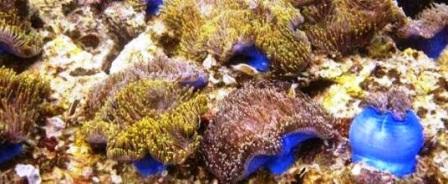Home › Sea Creatures › Marine Biology › Invertebrates › Sea Anemones
Interesting Facts about Sea Anemones
[Sea Anemone Phylum: Cnidaria] [Class: Anthozoa] [Subclass: Hexacorallia] [Order: Actiniaria]
These marine invertebrates get their common name from the colourful displays that resemble terrestrial anemone windflowers. But, the scientific name of sea anemone is the biological classification "Actiniaria".
This section contains fun facts and information about sea anemones, including where to find them, what they eat, and how they reproduce.
Is the Sea Anemone an Animal or a Plant?
In fact, they do not have a nervous system so you might think they are plants.
However, around 5,000 species of demospongiae belong to the phylum Porifera (e.g. marine invertebrates and pore bearers).
Thus, sea anemones are aquatic animals that thrive best in temperate warm water environments, and some brackish waters.
More than one thousand different species exist in the deep and shallow intertidal zones of most oceans - especially the tropics.
The phylum of sea anemone is Cnidarian. It's a group closely related to some common species of coral and jellyfish species. The clade also includes other tube-dwelling sea anemones and Hydra.
Sea Anemone Characteristics
By and large, most sea anemone species attach themselves to solid underwater structures, such as artificial reefs, rocks, boulders, the shells of marine organisms, and even sunken wharf timber.
It's also common to see them hiding in small crevices or underneath seaweed. Even so, some Actiniaria will burrow themselves into sandy sediment or mud.
Here's the thing:
The typical structure of a sea anemone is a single polyp. In general, each polyp has a trunk with a ring of tentacles that extend outwards from an oral disc, and its mouth located in the middle.
The biggest sea anemone is Mertens' carpet sea anemone (Stichodactyla mertensii), which often grows more than one metre in diameter (3.3 feet). But, an average sea anemone size is around five (5) centimetres in diameter and nine (9) centimetres long (3 inches).
Pro Tip: Another segment contains further information about sea anemone anatomy with a list of anatomical body parts and definitions.
What Do Ocean Anemones Eat?
When they're not using the stinging cells (cnidocytes) to ensnare prey, most sea anemone species can retract their tentacles back inside the body cavity.
 For the most part, nourishment comes from various kinds of symbiotic relationships with other organisms, especially:
For the most part, nourishment comes from various kinds of symbiotic relationships with other organisms, especially:
- Anemonefish (clownfish)
- Hermit crabs (Paguridae)
- Green algae
- Single-celled dinoflagellates
- Zooxanthellae
Ocean anemones are carnivorous predators. They use their stinging tentacles and lips to devour large crustaceans (e.g. crabs, sea urchins), and various kinds of marine molluscs.
Different Types of Sea Anemone
Adhesive Anemone (Cryptodendrum adhaesivum)
Anthopleura Ballii
Beadlet Anemone (Actinia equina)
Berried Anemone (Alicia mirabilis)
Bolocera Tuediae
Bubble-Tip Anemone (E. quadricolor)
The hardy "Entacmaea quadricolor" is a popular choice of sea anemone kept in the marine aquarium trade and its bulbous tips make it one of the most striking.
Another page contains interesting facts about the bubble-tip sea anemone, including where they live, what they eat, and how they regenerate asexually.
Carpet Anemone
Cereus Pedunculatus
Columbia Sand Anemone
Dahlia Anemone
Edwardsia Timida
Fat Anemone (Cribrinopsis crassa)
Giant Carpet Anemone (Stichodactyla gigantea)
Giant Plumose Anemone (Metridium farcimen)
Golden Anemone (Condylactis aurantiaca)
Haddon's Sea Anemone (Stichodactyla haddoni)
Halcampoides Abyssorum
Hell's Fire Anemone (Actinodendron arboreum)
Leathery Sea Anemone
Despite its leathery appearance, the long flowing white or light tan tentacles of sebae anemone (Heteractis crispa) usually have purple or blue tips.
Leptopsammia Pruvoti
Magnificent Sea Anemone (Radianthus magnifica)
Mertens' Carpet Sea Anemone
Night Anemone
Parazoanthus Anguicomus
Prolific Anemone (Triactis producta)
Snakelocks Anemone (Anemonia viridis)
Starlet Sea Anemone (Nematostella vectensis)
Stinging Anemone (Lebrunia danae)
How Do Sea Anemones Reproduce?
In fact, sea anemones can reproduce sexually, by casting sperm and eggs into the water column, and by asexual reproduction (e.g. the regeneration of new polyps).
After fertilisation, the eggs drift with plankton until they have developed into free-swimming larvae. At this point, they will find a suitable place on the seabed to settle and grow into juvenile polyps.
Threats and Predators
Our fish aquarium beginners guide explains why some hobbyists are using sea anemones in reef aquariums. As a consequence of that, some sea anemone populations are decreasing in certain regions around the world.
So, what eats sea anemones in the wild? In fact, their common enemies include a range of fish families (especially pufferfish), sea snails, sea stars, and sea turtles.
Important: The IUCN Red List of Threatened Species is a comprehensive source of information about the global conservation status of animals, fungi, and plants. Currently, the IUCN lists most sea anemones species as Least Concern (LC).
Related Information and Help Guides
- A to Z List of Marine Invertebrates Examples
- Sea Sponge Facts and Information with Pictures
- Sea Fans Fun Facts and Interesting Information
- Sea Spider Habitat and Life Cycle with Pictures
- Sea Squirts: Fun Facts about Tunicates
Note: The short video [2:21 minutes] presented by "Deep Marine Scenes" contains more sea anemone facts and explains why Actiniaria is an ideal home for the clownfish.